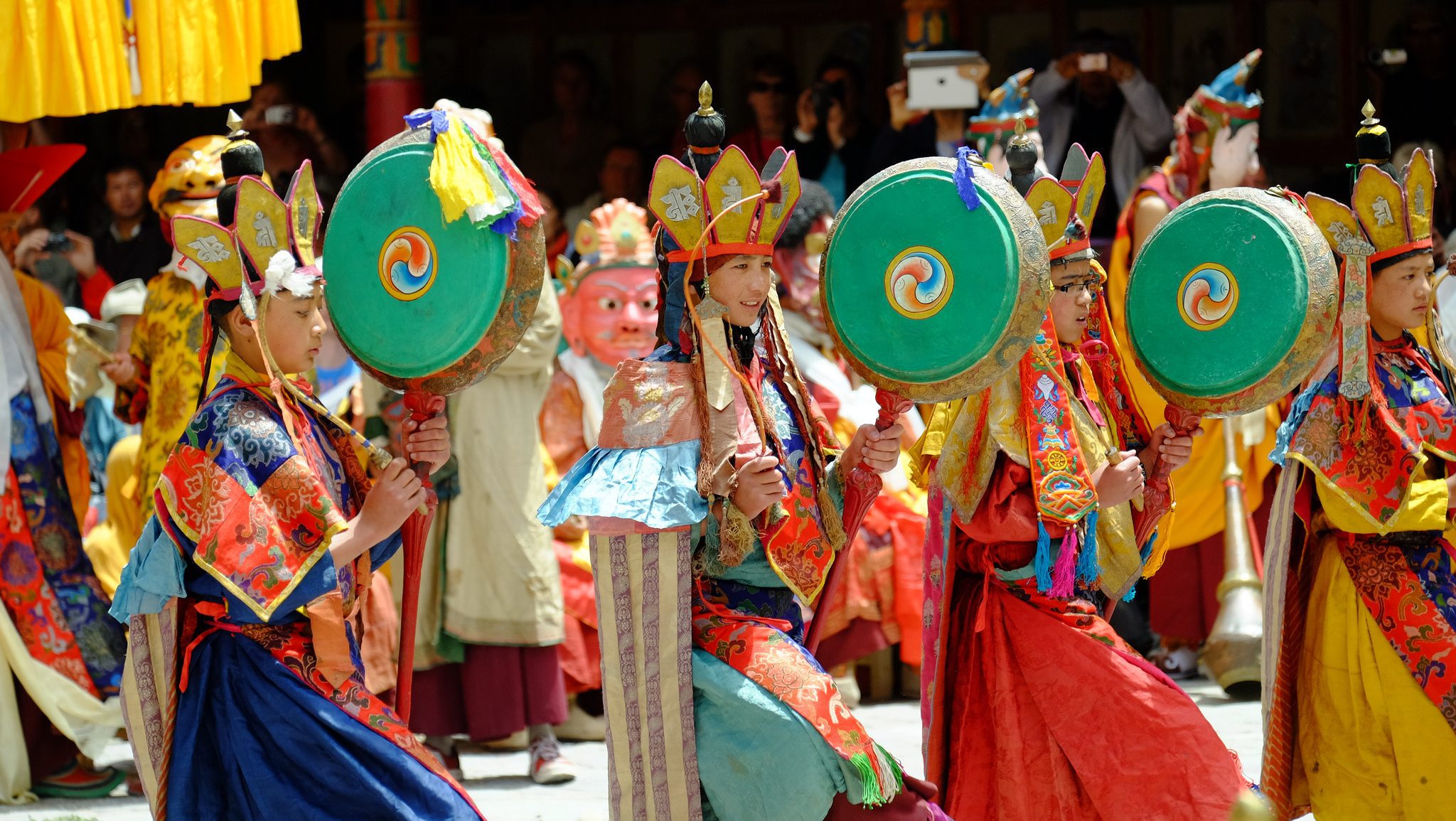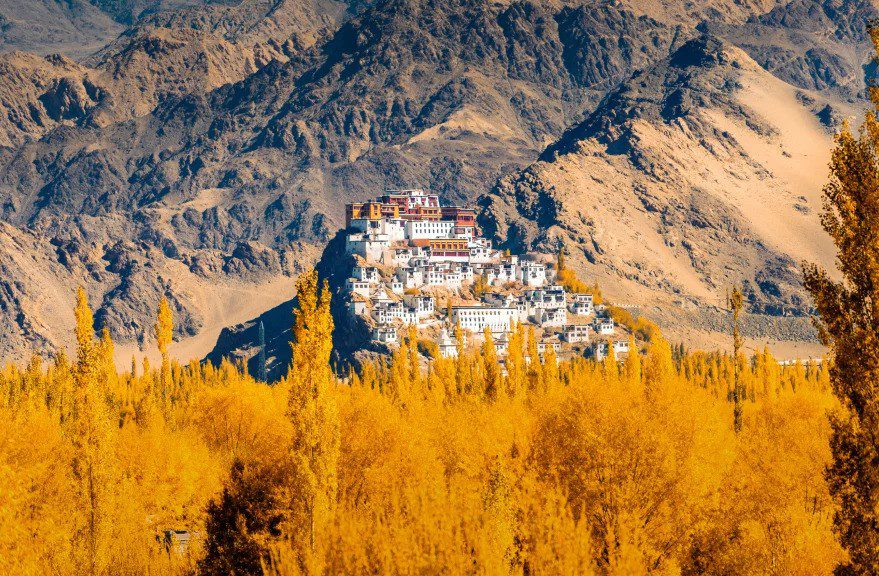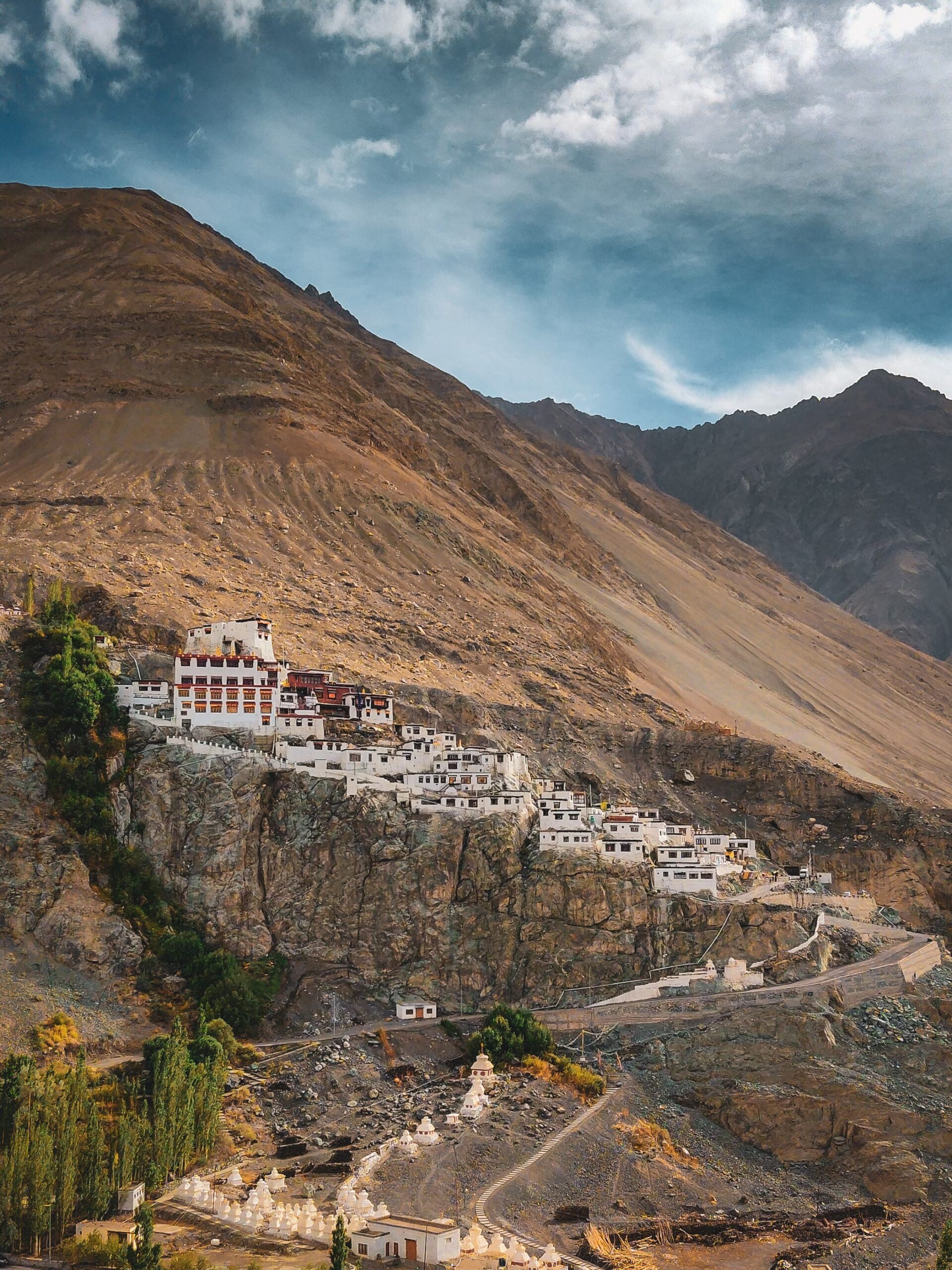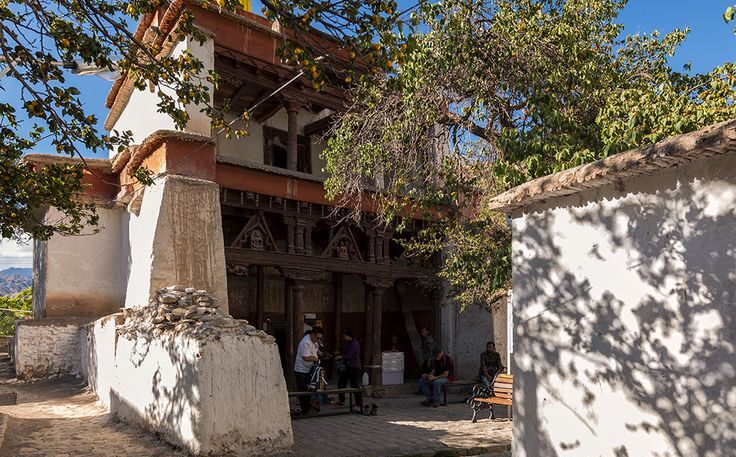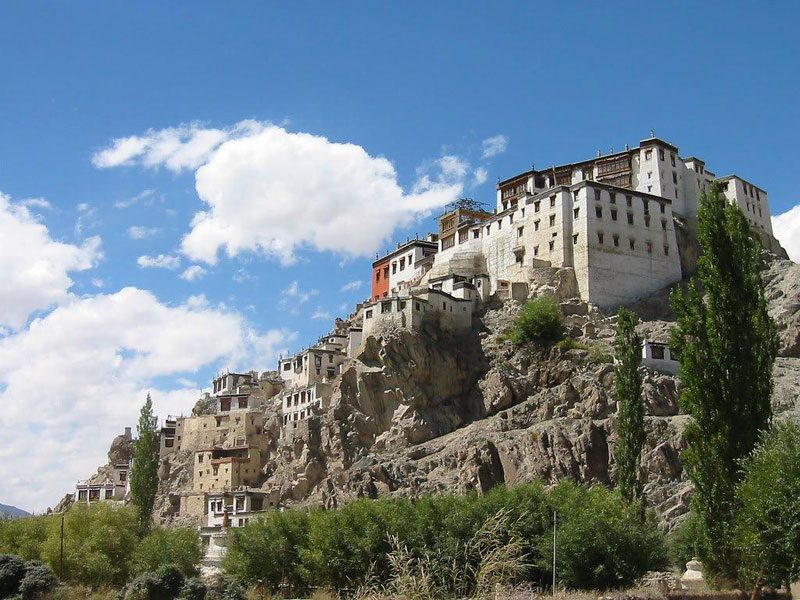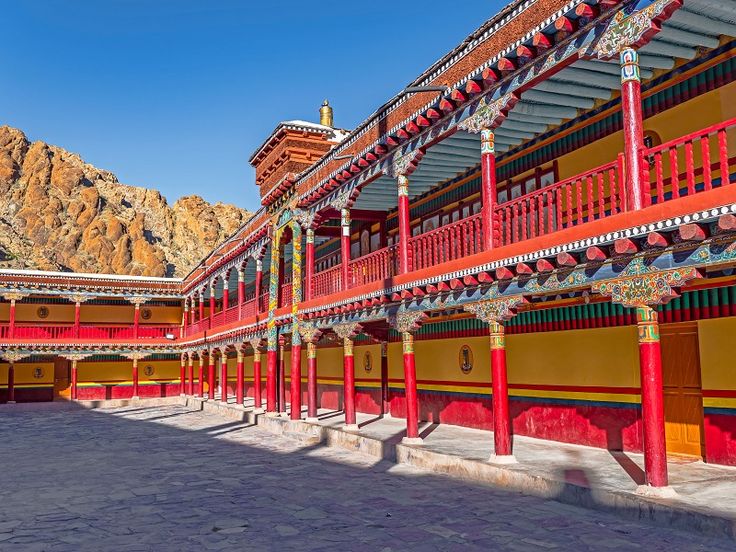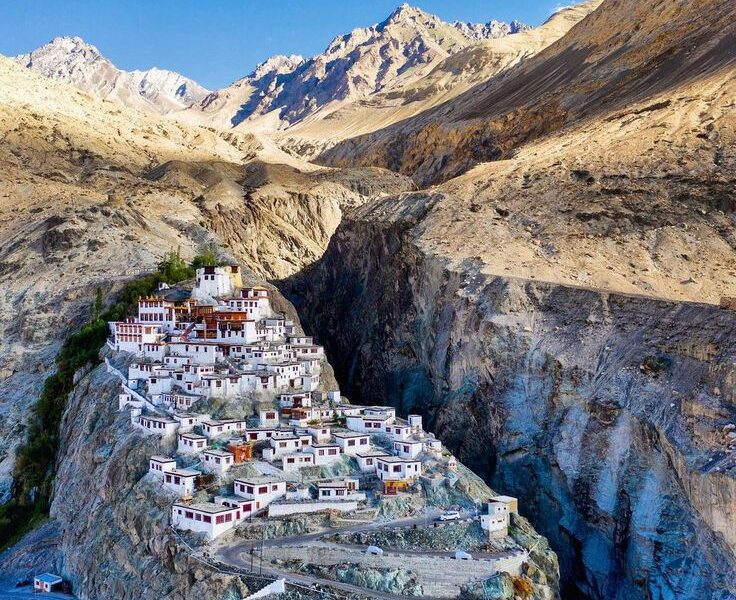Discover Ladakh’s top monasteries and explore the heart of its Buddhist heritage, ancient art, and scenic beauty. A perfect guide for those seeking a spiritual and scenic journey through the Himalayas!
Introduction to Ladakh’s Rich Monastic Heritage
Ladakh, often called “The Land of High Passes,” is not only famous for its breathtaking Himalayan landscapes but also for its ancient monasteries that are steeped in Buddhist culture and history. These monasteries, also known as “gompas,” have attracted travelers, pilgrims, and explorers from all over the world. With their serene surroundings, intricate architecture, and rich spiritual traditions, Ladakh’s monasteries offer a glimpse into the timeless cultural heritage of the region. In this guide, we’ll take you through the top five must-visit monasteries in Ladakh, showcasing their unique features, historical significance, and unmissable experiences.
1. Hemis Monastery – Ladakh’s Largest and Richest Monastery
Exploring the Spiritual Essence of Hemis Monastery

Hemis Monastery, located about 45 km from Leh, is the largest and wealthiest monastery in Ladakh. Founded in the 17th century, Hemis has become a spiritual hub for those seeking peace and history in the Himalayas. Its isolated valley location and elaborate construction make it one of the most visited spiritual sites in Ladakh.
“Visiting Hemis Monastery was a life-changing experience. The tranquil environment and the deep-rooted history of this place transported me to another world. I felt at peace and connected to the culture.”
– Emily Williams, Teacher, USA
Hemis Monastery Festival – A Celebration of Buddhist Culture
The Hemis Festival, celebrated every summer, is one of Ladakh’s most famous events. Known for its colorful mask dances and lively music, the festival attracts both locals and tourists who want to witness the cultural richness of Ladakh. Monks perform Cham dances to honor Guru Padmasambhava, adding a mystical allure to the festivities.
| Feature |
Details |
| Founded |
1630 AD |
| Location |
45 km from Leh |
| Famous Festival |
Hemis Festival |
| Highlight |
Largest monastery in Ladakh |
2. Thiksey Monastery – The Mini-Potala of Ladakh
Thiksey’s Iconic Architecture and Panoramic Views

Situated just 19 km from Leh, Thiksey Monastery is often compared to the Potala Palace of Lhasa, earning it the title “Mini-Potala.” With its twelve-story complex, this monastery houses one of the most breathtaking collections of Buddhist art and relics. Thiksey also offers spectacular views of the Indus Valley, making it a popular destination for photographers.
“Thiksey was the highlight of my Ladakh trip. I loved the peaceful ambiance and the view of the Indus Valley was mesmerizing. The intricate details in the monastery were beyond my expectations.”
– Oliver Smith, Photographer, United Kingdom
Must-See Attractions within Thiksey Monastery
The Maitreya Buddha statue, a two-story tall golden statue, is one of the most popular sights in Thiksey. The assembly hall, filled with murals and ancient manuscripts, offers insight into the Buddhist teachings. Thiksey is not only a cultural landmark but also a place where visitors can experience traditional monastic life.
3. Diskit Monastery – Home of the Majestic Maitreya Buddha Statue
Diskit Monastery – Gateway to the Nubra Valley

Diskit Monastery is the largest and oldest monastery in Nubra Valley. It was established in the 14th century and is perched atop a hill overlooking the Shyok River. The monastery’s stunning location makes it a gateway to the Nubra Valley and an iconic site for those visiting the region.
“I’ll never forget the feeling of peace I experienced at Diskit Monastery. Seeing the massive Buddha statue against the beautiful valley backdrop was just surreal.”
– Liam Anderson, Software Developer, Canada
The 32-Meter Maitreya Buddha – A Symbol of Peace
One of the most notable features of Diskit is its 32-meter Maitreya Buddha statue, which was constructed in 2010. The statue, facing Pakistan, symbolizes peace and protection. It’s a stunning landmark, particularly during sunrise and sunset when it is bathed in golden light.
4. Alchi Monastery – Ladakh’s Artistic Treasure
Unraveling the Artistic Legacy of Alchi Monastery

Alchi Monastery, dating back to the 11th century, is known for its Indo-Tibetan art, including exquisite frescoes and wood carvings. Unlike most monasteries in Ladakh, which are perched on hills, Alchi is situated on flat terrain by the Indus River. This unique setting has helped preserve its ancient artifacts, offering visitors a rare glimpse into Ladakh’s medieval past.
“As an art enthusiast, Alchi Monastery was a dream come true. The murals were unlike anything I had ever seen, full of rich colors and intricate details.”
– Sophia Martinez, Art Curator, Spain
Exploring Alchi’s Ancient Murals and Frescoes
The frescoes and murals in Alchi are a testament to the artistic heritage of Ladakh. They showcase Buddhist and Hindu influences, a rarity in Ladakh’s predominantly Tibetan-style artwork. Visitors can spend hours admiring these intricate designs, which narrate tales of Buddhism’s journey through the Himalayas.
| Feature |
Details |
| Founded |
11th century |
| Art Style |
Indo-Tibetan |
| Famous For |
Frescoes and murals |
| Location |
Alchi Village, near the Indus |
5. Spituk Monastery – A Tranquil Site with Panoramic Views of the Indus
Spituk’s Scenic Location Overlooking the Indus River

Perched on a hill overlooking the Indus River, Spituk Monastery offers visitors stunning views of Ladakh’s dramatic landscape. This 11th-century monastery is known for its calm and quiet ambiance, making it a favorite for travelers seeking solace.
“The peaceful setting of Spituk Monastery helped me disconnect from the busy world. It was the perfect spot to meditate and reflect.”
– Ethan Brown, Environmental Scientist, Australia
Spituk Gustor Festival – A Glimpse into Ladakhi Rituals
Every January, the Spituk Gustor Festival is celebrated with Cham dances and rituals. The festival provides a glimpse into Ladakhi customs, attracting visitors interested in exploring the spiritual and ritualistic aspects of Buddhism in Ladakh.
Planning Your Ladakh Monastery Tour
Best Time to Visit Ladakh’s Monasteries
Ladakh’s monasteries are accessible year-round, but the best time to visit is from May to September when the weather is pleasant, and the roads are accessible. Winter offers a quieter experience but requires proper preparation due to Ladakh’s extreme cold.
Essential Tips for Visiting Ladakh’s Monasteries
- Respect local customs: Visitors should dress modestly and avoid loud conversations.
- Photography guidelines: Some monasteries allow photography, but certain areas may be restricted.
- Altitude awareness: Acclimatize gradually and stay hydrated to avoid altitude sickness.
The Spiritual Significance of Buddhism in Ladakh
Buddhism’s Deep Roots in Ladakhi Culture

Buddhism is at the heart of Ladakhi life, influencing its culture, festivals, and daily routines. Monasteries in Ladakh are not only religious sites but also cultural preservation centers where Buddhist teachings, rituals, and art are safeguarded.
“Understanding Buddhism’s impact on Ladakh’s culture enriched my experience. The monasteries aren’t just buildings; they’re living symbols of peace and wisdom.”
– Rachel Thompson, Historian, South Africa
Experiencing Peace and Tranquility at Ladakh Monasteries
Visiting a monastery in Ladakh is more than just sightseeing. These places offer a peaceful ambiance that fosters introspection and spiritual growth. Many visitors describe their experience as life-changing, as they connect with the serenity that the monasteries provide.
FAQs About Visiting Monasteries in Ladakh
Which is the largest monastery in Ladakh?
Hemis Monastery is the largest and wealthiest monastery in Ladakh, drawing numerous tourists and pilgrims every year.
When is the best time to visit Ladakh’s monasteries?
The ideal time to visit Ladakh’s monasteries is from May to September for accessible travel and pleasant weather.
How should I prepare for high-altitude visits to monasteries?
Gradual acclimatization, staying hydrated, and avoiding strenuous activities on the first day can help prevent altitude sickness.
Can tourists visit Ladakh’s monastery festivals?
Yes, tourists are welcome to attend festivals like Hemis Festival and Spituk Gustor, providing a firsthand experience of Ladakhi customs.
What should I wear when visiting a monastery in Ladakh?
Dress modestly, covering shoulders and legs, and avoid flashy clothing to respect local customs.
Q&A Section
Is photography allowed in Ladakh’s monasteries?
Photography is permitted in many monasteries, but certain sacred areas may have restrictions. Always ask before taking photos inside the monasteries.
Are there meditation programs available at these monasteries?
Some monasteries, such as Hemis and Thiksey, occasionally offer meditation programs. Check with local tour guides for available programs during your visit.
What is the altitude of Ladakh’s monasteries?
Most monasteries in Ladakh are at an altitude of around 10,000-13,000 feet. It’s essential to acclimatize slowly and drink plenty of water.
Ladakh monasteries
Ladakh monasteries | The journey through Ladakh mirrors the very essence of unraveling unknown horizons, as its dramatic landscapes and unique cultural identity awaken the deepest sense of wonder and exploration. Ladakh monasteries delves into this realm where inner peace intertwines with the wild, untouched beauty of Ladakh. From the snow-capped peaks to the serene monasteries, every step in Ladakh is a step toward self-discovery. The mountains, ancient paths, and unspoken mysteries stretch before travelers, offering a meditative experience where each encounter feels both effortless and transformative. Whether it’s trekking across remote valleys or sitting quietly beside a sacred lake, Ladakh invites those who seek a deeper connection to the natural and spiritual world.

Ladakh monasteries
The monasteries of Ladakh stand as living monuments to the region’s profound spiritual heritage. With origins dating back over a thousand years, these ancient structures are both places of worship and repositories of art, culture, and wisdom. Hemis Monastery, one of the largest in Ladakh, is renowned for its annual festival, featuring colorful mask dances performed by monks. The history of these monasteries reflects Ladakh’s role as a crossroads between India, Tibet, and Central Asia, where religious and cultural influences have intertwined over the centuries.
The Tibetan Buddhist influence is especially evident in the architecture and daily life of the monks. Prayer wheels, intricate murals, and the soft hum of chants fill the air as visitors explore the monastery grounds. Each monastery, from the remote Lamayuru to the awe-inspiring Thiksey, offers a window into the spiritual heart of Ladakh. These centers of meditation, learning, and community life continue to thrive, preserving traditions that have shaped Ladakh for generations.
Why Visit Ladakh for Ladakh monasteries?
Ladakh is a destination that transcends mere travel. It offers a journey that touches both the outer and inner landscapes, making it a perfect setting for those who seek to unravel their own unknown horizons. The region’s breathtaking scenery—from towering mountain ranges to hidden valleys—provides not just an escape but a space for contemplation and growth. Ladakh’s culture, deeply rooted in Buddhist practices, invites visitors to reflect on their own lives and the world around them.
Ladakh’s people, known for their warmth and hospitality, add to the richness of the experience. Villages like Sumda Chun and the legendary Nubra Valley introduce travelers to a way of life that is intricately connected to nature and spirituality. Staying in local homestays allows for immersive experiences where one can learn about traditional Ladakhi customs, share meals made from local produce, and participate in community rituals.

Beyond its natural beauty, Ladakh offers a unique opportunity to explore oneself. The vastness of the region’s plateaus and the clarity of its skies seem to mirror the vastness of the human spirit. Whether it’s standing atop a mountain pass at 18,000 feet or meditating in a centuries-old monastery, Ladakh helps unravel the unknown horizons within each traveler.
Finding the Best Ladakh monasteries in Ladakh
Finding the best places in Ladakh to experience “Ladakh monasteries” involves venturing off the beaten path. Ladakh’s lesser-known treks, such as those leading to secluded monasteries or high-altitude lakes, offer unparalleled opportunities for solitude and reflection. The Markha Valley trek, for instance, takes travelers through verdant valleys, ancient villages, and high-altitude passes, allowing for both physical and spiritual exploration.
Ladakh’s iconic lakes, including Pangong Tso and Tso Moriri, are ideal spots for quiet contemplation. Their still waters reflect the sky, creating a mesmerizing landscape that feels timeless and infinite. Sitting beside these lakes, especially at dawn or dusk, brings an overwhelming sense of peace and connection with nature.

For those interested in Ladakh’s spiritual heritage, exploring monasteries such as Alchi, Phyang, or Diskit can be a transformative experience. These sites are not just places of worship but also centers of art, philosophy, and wisdom. Visiting these monasteries, with their ancient murals and intricate statues, offers insight into Ladakh’s rich cultural tapestry.
Ladakh’s Atmosphere and Ladakh monasteries
Ladakh’s atmosphere is unlike any other place on Earth. The stark contrasts between the rugged mountains and the serene, tranquil monasteries create an environment that feels both raw and sacred. The traditional decor in Ladakhi homes and religious sites reflects this balance, with mud-brick houses adorned with prayer flags and colorful thangkas (Buddhist paintings) that add warmth and spiritual meaning to the space.

The interiors of Ladakhi homes, often simple and functional, are filled with symbols of devotion. Small shrines dedicated to Buddhist deities are common, and the air is often fragrant with incense. The use of earthy materials, like stone and wood, along with brightly colored textiles, creates an inviting and peaceful space, perfect for relaxation and reflection.
Traditional Ladakhi Cuisine
Traditional Ladakhi cuisine is an integral part of the region’s identity, offering a unique blend of flavors that reflect its harsh climate and remote location. Hearty, warming dishes such as thukpa (noodle soup) and momos (dumplings) provide the sustenance needed to endure Ladakh’s cold temperatures. Skyu, a thick stew made with root vegetables and barley, is another staple of the Ladakhi diet, designed to nourish both body and spirit.

Drinks like butter tea, made with yak butter and salt, are a must-try for anyone visiting Ladakh. This rich, savory drink is not only warming but also hydrating, making it essential for those venturing into the high-altitude regions of Ladakh. Chang, a local barley beer, is often enjoyed during festivals and community gatherings, adding a sense of joy and camaraderie to any occasion.
Live Cultural Ladakh monasteries in Ladakh
Ladakh is home to a vibrant cultural scene, with festivals and live performances held throughout the year. The Hemis Festival, which celebrates the birth of Guru Padmasambhava, is one of the largest and most famous events in the region. Monks dressed in elaborate costumes perform cham dances, which depict the triumph of good over evil. The energy of the festival, with its bright colors, rhythmic music, and elaborate rituals, draws visitors from around the world.
Other local festivals, such as the Losar (New Year) and Ladakh Festival, provide visitors with the chance to witness traditional dance, music, and crafts that have been passed down through generations. These events are more than just entertainment; they are a celebration of Ladakh’s rich cultural heritage and its deep connection to the spiritual world.
Trekking and Outdoor Activities Ladakh monasteries
Ladakh is a trekker’s paradise, offering some of the most stunning and challenging routes in the world. From the famous Ladakh monasteries, which follows the frozen Zanskar River, to lesser-known routes like the Sham Valley or Nubra Valley treks, Ladakh’s landscape offers endless possibilities for adventure and discovery. The high-altitude passes, such as Khardung La and Chang La, offer breathtaking views of snow-capped peaks and sprawling valleys.

Wildlife enthusiasts will also find Ladakh monasteries to be a haven for rare species such as the snow leopard, Himalayan blue sheep, and the Tibetan wild ass. Winter expeditions to spot the elusive snow leopard in the Hemis National Park are gaining popularity among wildlife photographers and conservationists alike.
The Importance of Preserving Ladakh’s Ladakh monasteries
Ladakh’s rich cultural and environmental Ladakh monasteries is under increasing threat from climate change and mass tourism. Preserving this unique region requires careful attention to sustainable tourism practices. Choosing eco-friendly accommodations, supporting local businesses, and participating in community-led conservation efforts are just a few ways that visitors can contribute to the preservation of Ladakh’s natural and cultural heritage.
Ladakh’s people have a long history of living in harmony with their environment, practicing sustainable agriculture, and maintaining a deep spiritual connection to the land. Visitors are encouraged to follow the same principles, leaving no trace and respecting the fragile ecosystems that make Ladakh so special.
Etiquette and Tips for Visiting Ladakh monasteries
Before visiting Ladakh, it’s essential to understand and respect the region’s customs and traditions. As a deeply spiritual place, Ladakh requires visitors to dress modestly, especially when visiting monasteries or attending religious ceremonies. Always ask for permission before taking photographs inside monasteries or of local people.
Medical Ladakh monasteries
Spa trail Ladakh monasteries
Ladakh monasteries

When Ladakh monasteries, remember to stay on designated paths to avoid damaging fragile ecosystems. Tipping is appreciated but not expected in most settings, and it’s important to carry cash, as many remote areas do not accept credit cards. Lastly, be mindful of altitude sickness and take the necessary precautions when traveling to higher elevations.
Conclusion: Enjoying Ladakh monasteries in Ladakh
Ladakh is a place where the physical and spiritual worlds converge, offering travelers a journey unlike any other. Whether you’re trekking across high-altitude deserts, exploring ancient monasteries, or simply sitting in quiet reflection by a mountain lake, Ladakh invites you to unravel your own unknown horizons. By respecting the region’s traditions and practicing sustainable tourism, you help ensure that Ladakh’s beauty and cultural richness will be preserved for future generations to explore and enjoy.
